Ehsan Adeli
Department of Computer Science, Stanford University, Stanford, CA, USA, Department of Psychiatry and Behavioral Sciences, Stanford University, Stanford, CA, USA
Artist-Created Mesh Generation from Raw Observation
Sep 15, 2025Abstract:We present an end-to-end framework for generating artist-style meshes from noisy or incomplete point clouds, such as those captured by real-world sensors like LiDAR or mobile RGB-D cameras. Artist-created meshes are crucial for commercial graphics pipelines due to their compatibility with animation and texturing tools and their efficiency in rendering. However, existing approaches often assume clean, complete inputs or rely on complex multi-stage pipelines, limiting their applicability in real-world scenarios. To address this, we propose an end-to-end method that refines the input point cloud and directly produces high-quality, artist-style meshes. At the core of our approach is a novel reformulation of 3D point cloud refinement as a 2D inpainting task, enabling the use of powerful generative models. Preliminary results on the ShapeNet dataset demonstrate the promise of our framework in producing clean, complete meshes.
Integrating Anatomical Priors into a Causal Diffusion Model
Sep 10, 2025Abstract:3D brain MRI studies often examine subtle morphometric differences between cohorts that are hard to detect visually. Given the high cost of MRI acquisition, these studies could greatly benefit from image syntheses, particularly counterfactual image generation, as seen in other domains, such as computer vision. However, counterfactual models struggle to produce anatomically plausible MRIs due to the lack of explicit inductive biases to preserve fine-grained anatomical details. This shortcoming arises from the training of the models aiming to optimize for the overall appearance of the images (e.g., via cross-entropy) rather than preserving subtle, yet medically relevant, local variations across subjects. To preserve subtle variations, we propose to explicitly integrate anatomical constraints on a voxel-level as prior into a generative diffusion framework. Called Probabilistic Causal Graph Model (PCGM), the approach captures anatomical constraints via a probabilistic graph module and translates those constraints into spatial binary masks of regions where subtle variations occur. The masks (encoded by a 3D extension of ControlNet) constrain a novel counterfactual denoising UNet, whose encodings are then transferred into high-quality brain MRIs via our 3D diffusion decoder. Extensive experiments on multiple datasets demonstrate that PCGM generates structural brain MRIs of higher quality than several baseline approaches. Furthermore, we show for the first time that brain measurements extracted from counterfactuals (generated by PCGM) replicate the subtle effects of a disease on cortical brain regions previously reported in the neuroscience literature. This achievement is an important milestone in the use of synthetic MRIs in studies investigating subtle morphological differences.
Curriculum-Guided Layer Scaling for Language Model Pretraining
Jun 13, 2025Abstract:As the cost of pretraining large language models grows, there is continued interest in strategies to improve learning efficiency during this core training stage. Motivated by cognitive development, where humans gradually build knowledge as their brains mature, we propose Curriculum-Guided Layer Scaling (CGLS), a framework for compute-efficient pretraining that synchronizes increasing data difficulty with model growth through progressive layer stacking (i.e. gradually adding layers during training). At the 100M parameter scale, using a curriculum transitioning from synthetic short stories to general web data, CGLS outperforms baseline methods on the question-answering benchmarks PIQA and ARC. Pretraining at the 1.2B scale, we stratify the DataComp-LM corpus with a DistilBERT-based classifier and progress from general text to highly technical or specialized content. Our results show that progressively increasing model depth alongside sample difficulty leads to better generalization and zero-shot performance on various downstream benchmarks. Altogether, our findings demonstrate that CGLS unlocks the potential of progressive stacking, offering a simple yet effective strategy for improving generalization on knowledge-intensive and reasoning tasks.
Anatomical Similarity as a New Metric to Evaluate Brain Generative Models
Apr 30, 2025Abstract:Generative models enhance neuroimaging through data augmentation, quality improvement, and rare condition studies. Despite advances in realistic synthetic MRIs, evaluations focus on texture and perception, lacking sensitivity to crucial anatomical fidelity. This study proposes a new metric, called WASABI (Wasserstein-Based Anatomical Brain Index), to assess the anatomical realism of synthetic brain MRIs. WASABI leverages \textit{SynthSeg}, a deep learning-based brain parcellation tool, to derive volumetric measures of brain regions in each MRI and uses the multivariate Wasserstein distance to compare distributions between real and synthetic anatomies. Based on controlled experiments on two real datasets and synthetic MRIs from five generative models, WASABI demonstrates higher sensitivity in quantifying anatomical discrepancies compared to traditional image-level metrics, even when synthetic images achieve near-perfect visual quality. Our findings advocate for shifting the evaluation paradigm beyond visual inspection and conventional metrics, emphasizing anatomical fidelity as a crucial benchmark for clinically meaningful brain MRI synthesis. Our code is available at https://github.com/BahramJafrasteh/wasabi-mri.
VideoMultiAgents: A Multi-Agent Framework for Video Question Answering
Apr 30, 2025Abstract:Video Question Answering (VQA) inherently relies on multimodal reasoning, integrating visual, temporal, and linguistic cues to achieve a deeper understanding of video content. However, many existing methods rely on feeding frame-level captions into a single model, making it difficult to adequately capture temporal and interactive contexts. To address this limitation, we introduce VideoMultiAgents, a framework that integrates specialized agents for vision, scene graph analysis, and text processing. It enhances video understanding leveraging complementary multimodal reasoning from independently operating agents. Our approach is also supplemented with a question-guided caption generation, which produces captions that highlight objects, actions, and temporal transitions directly relevant to a given query, thus improving the answer accuracy. Experimental results demonstrate that our method achieves state-of-the-art performance on Intent-QA (79.0%, +6.2% over previous SOTA), EgoSchema subset (75.4%, +3.4%), and NExT-QA (79.6%, +0.4%). The source code is available at https://github.com/PanasonicConnect/VideoMultiAgents.
AdaVid: Adaptive Video-Language Pretraining
Apr 16, 2025Abstract:Contrastive video-language pretraining has demonstrated great success in learning rich and robust video representations. However, deploying such video encoders on compute-constrained edge devices remains challenging due to their high computational demands. Additionally, existing models are typically trained to process only short video clips, often limited to 4 to 64 frames. In this paper, we introduce AdaVid, a flexible architectural framework designed to learn efficient video encoders that can dynamically adapt their computational footprint based on available resources. At the heart of AdaVid is an adaptive transformer block, inspired by Matryoshka Representation Learning, which allows the model to adjust its hidden embedding dimension at inference time. We show that AdaVid-EgoVLP, trained on video-narration pairs from the large-scale Ego4D dataset, matches the performance of the standard EgoVLP on short video-language benchmarks using only half the compute, and even outperforms EgoVLP when given equal computational resources. We further explore the trade-off between frame count and compute on the challenging Diving48 classification benchmark, showing that AdaVid enables the use of more frames without exceeding computational limits. To handle longer videos, we also propose a lightweight hierarchical network that aggregates short clip features, achieving a strong balance between compute efficiency and accuracy across several long video benchmarks.
Re-thinking Temporal Search for Long-Form Video Understanding
Apr 03, 2025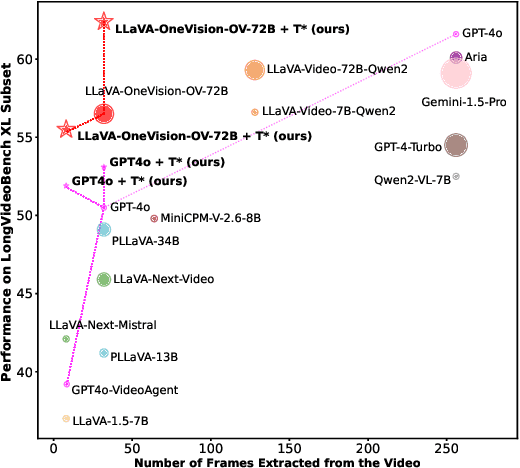
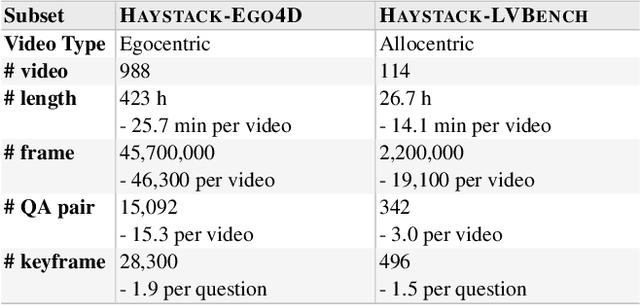
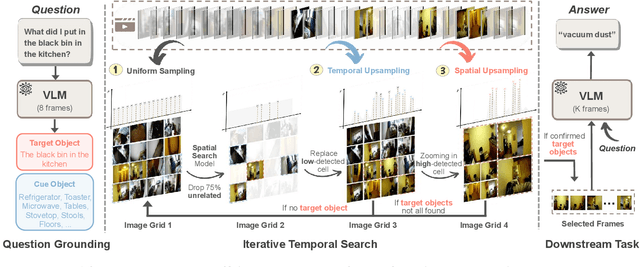
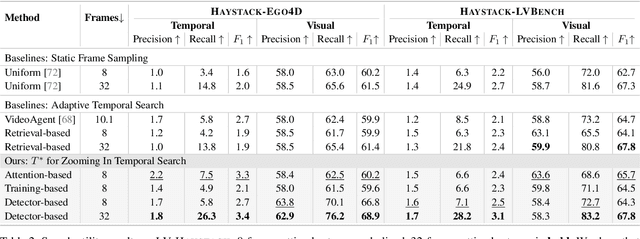
Abstract:Efficient understanding of long-form videos remains a significant challenge in computer vision. In this work, we revisit temporal search paradigms for long-form video understanding, studying a fundamental issue pertaining to all state-of-the-art (SOTA) long-context vision-language models (VLMs). In particular, our contributions are two-fold: First, we formulate temporal search as a Long Video Haystack problem, i.e., finding a minimal set of relevant frames (typically one to five) among tens of thousands of frames from real-world long videos given specific queries. To validate our formulation, we create LV-Haystack, the first benchmark containing 3,874 human-annotated instances with fine-grained evaluation metrics for assessing keyframe search quality and computational efficiency. Experimental results on LV-Haystack highlight a significant research gap in temporal search capabilities, with SOTA keyframe selection methods achieving only 2.1% temporal F1 score on the LVBench subset. Next, inspired by visual search in images, we re-think temporal searching and propose a lightweight keyframe searching framework, T*, which casts the expensive temporal search as a spatial search problem. T* leverages superior visual localization capabilities typically used in images and introduces an adaptive zooming-in mechanism that operates across both temporal and spatial dimensions. Our extensive experiments show that when integrated with existing methods, T* significantly improves SOTA long-form video understanding performance. Specifically, under an inference budget of 32 frames, T* improves GPT-4o's performance from 50.5% to 53.1% and LLaVA-OneVision-72B's performance from 56.5% to 62.4% on LongVideoBench XL subset. Our PyTorch code, benchmark dataset and models are included in the Supplementary material.
SocialGen: Modeling Multi-Human Social Interaction with Language Models
Mar 28, 2025Abstract:Human interactions in everyday life are inherently social, involving engagements with diverse individuals across various contexts. Modeling these social interactions is fundamental to a wide range of real-world applications. In this paper, we introduce SocialGen, the first unified motion-language model capable of modeling interaction behaviors among varying numbers of individuals, to address this crucial yet challenging problem. Unlike prior methods that are limited to two-person interactions, we propose a novel social motion representation that supports tokenizing the motions of an arbitrary number of individuals and aligning them with the language space. This alignment enables the model to leverage rich, pretrained linguistic knowledge to better understand and reason about human social behaviors. To tackle the challenges of data scarcity, we curate a comprehensive multi-human interaction dataset, SocialX, enriched with textual annotations. Leveraging this dataset, we establish the first comprehensive benchmark for multi-human interaction tasks. Our method achieves state-of-the-art performance across motion-language tasks, setting a new standard for multi-human interaction modeling.
Repurposing 2D Diffusion Models with Gaussian Atlas for 3D Generation
Mar 20, 2025Abstract:Recent advances in text-to-image diffusion models have been driven by the increasing availability of paired 2D data. However, the development of 3D diffusion models has been hindered by the scarcity of high-quality 3D data, resulting in less competitive performance compared to their 2D counterparts. To address this challenge, we propose repurposing pre-trained 2D diffusion models for 3D object generation. We introduce Gaussian Atlas, a novel representation that utilizes dense 2D grids, enabling the fine-tuning of 2D diffusion models to generate 3D Gaussians. Our approach demonstrates successful transfer learning from a pre-trained 2D diffusion model to a 2D manifold flattened from 3D structures. To support model training, we compile GaussianVerse, a large-scale dataset comprising 205K high-quality 3D Gaussian fittings of various 3D objects. Our experimental results show that text-to-image diffusion models can be effectively adapted for 3D content generation, bridging the gap between 2D and 3D modeling.
Towards Fine-Grained Video Question Answering
Mar 10, 2025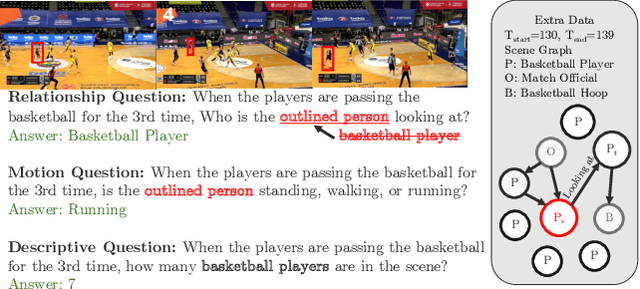


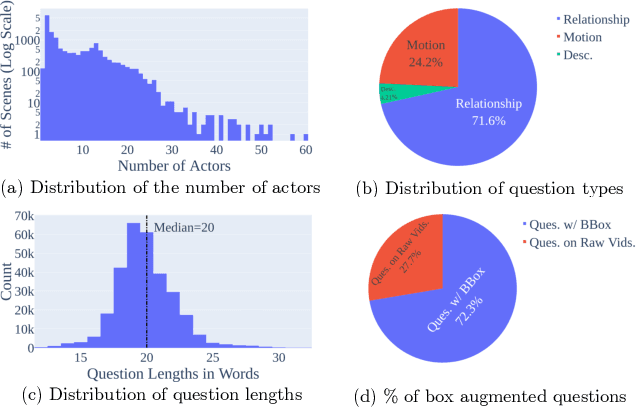
Abstract:In the rapidly evolving domain of video understanding, Video Question Answering (VideoQA) remains a focal point. However, existing datasets exhibit gaps in temporal and spatial granularity, which consequently limits the capabilities of existing VideoQA methods. This paper introduces the Multi-Object Multi-Actor Question Answering (MOMA-QA) dataset, which is designed to address these shortcomings by emphasizing temporal localization, spatial relationship reasoning, and entity-centric queries. With ground truth scene graphs and temporal interval annotations, MOMA-QA is ideal for developing models for fine-grained video understanding. Furthermore, we present a novel video-language model, SGVLM, which incorporates a scene graph predictor, an efficient frame retriever, and a pre-trained large language model for temporal localization and fine-grained relationship understanding. Evaluations on MOMA-QA and other public datasets demonstrate the superior performance of our model, setting new benchmarks for VideoQA.
 Add to Chrome
Add to Chrome Add to Firefox
Add to Firefox Add to Edge
Add to Edge